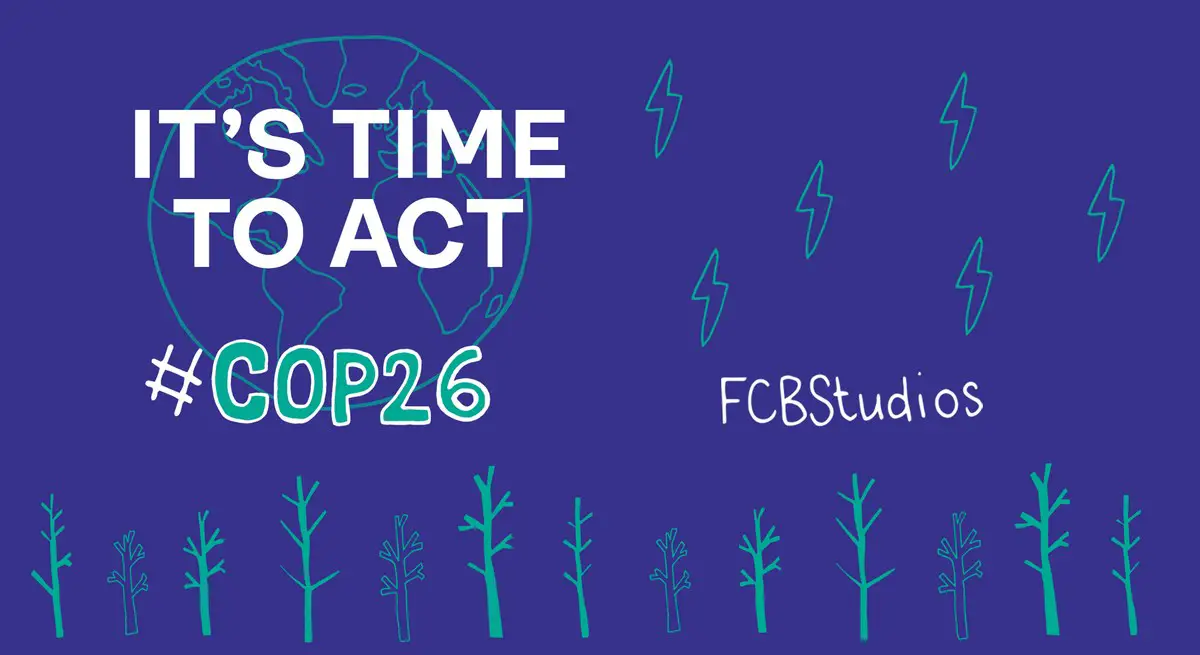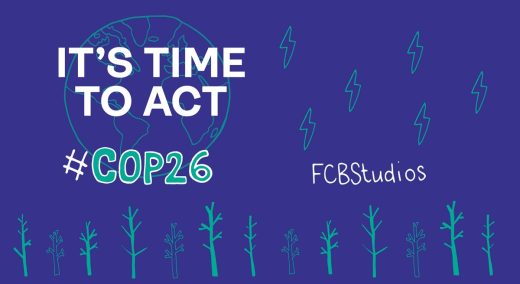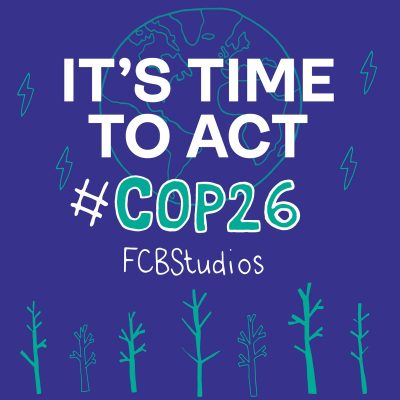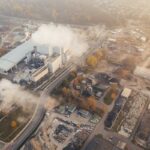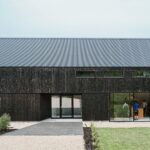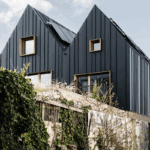Route to zero carbon FCBStudios, Beyond zero buildings, Eco architecture design
Route to zero carbon – view from FCBStudios
1 November 2021
Time to Act
In 2019, FCBStudios, along with many others, declared a climate emergency. Ian Taylor takes a view on what we have achieved since then, and where we are on our route to zero carbon.
As we approach COP26, there is no way of denying that it is Time to Act.
Route to zero carbon – COP26 Glasgow 2021
The next five years are going to be crucial to the survival of the planet. As designers, we are at the front end of the built environment’s carbon expenditure, designing projects that may take several years to complete. The industry needs to change its approach now.
In 2019, FCBStudios, along with many others, declared a climate emergency. We worked as part of the Architects Declare steering group to determine the eleven points of their manifesto – which made up the core of the declaration.
Importantly, responding to each of the manifesto points, we determined our own route map to reach net-zero by 2030 across our portfolio of projects.
Since then, we have worked to raise awareness, upskilled, and collaborated with others in the industry, developing means by which we can design buildings that have lower carbon impacts – especially focusing on their construction, which has not been well understood, and where data is scarce.
Raising Awareness
Personal carbon footprints. As part of our Global Climate Strike actions, we all calculated our own very rough carbon footprints, using the simple, but broadly indicative tool of the WWF Carbon footprint calculator in both 2019 and 2021. Overall, we had achieved a 15% reduction across the practice. The pandemic was a major factor in this reduction, significantly reducing transport impacts.
Office carbon footprints. We have been tracking our practice footprint for fifteen years. Last year we reported a footprint half that of our initial one. This year, partly due to the pandemic, with a reduction in travel, energy use and paper consumption, it was reduced by half again, reaching around 0.4t per person.
While last year was remarkable, the challenge for us now is to determine what we can take forward from this? What habits should we try and keep? In relation to our international and cross-office work I am personally encouraged that we have all learned that we can communicate well – though not perfectly – online, and we need to develop techniques to maximise the potential to build on this enforced shift.
Sharing Knowledge
As a practice of nearly 200 people, we have amassed a lot of knowledge on a diverse range of subjects, as well as contacts with lessons to share. Over the past two years, we have hosted 45 in-house CPD sessions by internal and external speakers on a broad range of sustainability issues, from detailing for air-tightness to circular economy and carbon sequestration.
Our experts from across the practice have also appeared as speakers at external events from regional Architectural Declares groups to numerous universities, professional organisations, conferences, and public audiences.
Peter Clegg was a founding member of Architects Declare, and our inhouse sustainability leaders sit on working groups within industry bodies including LETI, RIBA, CIBSE, UKGBC, and have been instrumental in forming The Embodied Carbon Group and the Part Z initiative.
Knowledge flows in both directions, and as a result, we are all more informed, more connected, and closer to reaching net zero.
We have initiated a number of campaigns that have sought to open up the conversation to diverse audiences:
What is net zero?
In our conversations, we realised that although the term net zero is used commonly, many people are still unsure of what it really means. What is net zero? was a collaboration with Beyond the Box to engage young people and reach out to audiences beyond the construction industry. We enabled a group of young people to respond to this question, sharing their answers with their audiences through events, podcasts and a zine.
Carbon Counts
The practice has always had a strong interest in reducing operational energy consumption in use, but in 2019, we acknowledged that we didn’t always understand the impacts of the construction of the buildings themselves.
The Carbon Counts exhibition explores the comparative impact of 10 common architectural materials. It has brought the concept and language of embodied carbon into the whole practice’s vocabulary, allowing us to engage our clients, consultants, school and university groups in the issue, encouraging discussion and awareness of embodied carbon in our projects.
FCBS CARBON
This desire to understand the impact of materials better led us to identify – and fill – a gap in industry knowledge. FCBS CARBON is a free and simple-to-use carbon calculator, designed to be used at the earliest stages of a project. Since its launch in October 2020, it has been downloaded by nearly 3000 unique users and continues a steady trajectory of industry interest. It recently won the AJ100 Sustainability Initiative of the Year award, with the judges noting: “[FCBS CARBON] is a major industry contribution, the right tool in the right place. This user-friendly platform enables designers to assess whole life carbon at concept stage when design – and carbon – decisions have the most impact.”
Upskilling
We want to enable people with distinct skills and interests to realise them. We now have four Passivhaus Designers and a Passivhaus consultant inhouse, with three more people currently doing the course. Each one of them is then able to bring their increased understanding of fabric first design to projects across the practice.
We have partnered with UCL and the University of Liverpool, and are now jointly supervising three PhD students and a KTP Research Associate, focussing on the embodied carbon within existing buildings, the resilience of higher education estates in the face of climate change; mitigation of climate change through building design; and zero-carbon design for extreme climates.
Our route to Net Zero
Our route to Net Zero takes a holistic view of the carbon impacts of buildings on the environment including consideration of the implications of material selection, construction, operation, maintenance, and end of life use. Our aim is that RIBA stage 3 proposals now include achievable zero carbon plans so we can understand what the client would have to do to operate at zero carbon in the future – even if in the short term it would include offsetting.
In addition, we want to develop meaningful design targets for embodied and operational carbon. We are currently collecting data on our built and in-progress projects to create a benchmark to measure future projects against. We are involved in industry discussions with the RIBA and insurers over the scope and inclusion of POE appointments to cover workstage 7 – mindful of the importance of supporting clients to help their buildings operate with low carbon impacts.
Next year, we want to be specifying, detailing and tendering projects to achieve net zero operational carbon in use and establish year on year improvements on how we can achieve that. On projects where we are already targeting zero carbon, a lot of work has been done which we now plan to disseminate across projects and to the industry.
Every practice should have a route to net zero. In 2020, I worked with Alasdair Ben Dixon, Collective Works, and Mina Hasman, SOM on behalf of the RIBA to create a framework for their Practice Roadmap which was presented to the conference in Autumn 2020 and has formed the basis of the Architects Declare Practice Guide, which is now available to download.
A Global Perspective
Whilst working from the UK, we need to maintain a global perspective on the global climate crisis. We tend to assume everyone has to reduce their ‘nationally determined contributions’ (NDC) to CO2 emissions. But you can’t do that if your population is growing incredibly fast and you haven’t got the water and the land to feed people. So the IPCC recognises that in the global south CO2 emissions will grow rapidly simply to meet basic human needs until the population stabilises, whilst ours need to fall even more rapidly.
Peter Clegg and Isabel Sandeman attended a conference about Climate Responsive Design, and subsequently published a Manifesto for Climate Responsive Design. The principles of this were further explored in an online resource, and we participated in a number of CPD sessions for the Commonwealth Architects Association. More than ever, design is contextual and should respond to local conditions.
Conclusion
Those of us working in the built environment have a much greater responsibility than most for the climate and biodiversity crises because of the long-term impact of the buildings we design. Our legacy can make a real difference. Changing our practice and our lifestyle is part of a process of changing the world.
Architecture is a long-term endeavour, and projects can take time to develop from concept to completion. Some of the projects completing now were conceived in a time when best practice was different, and we were less informed about the full carbon impacts. However, we are constantly questioning our actions, our decisions and what is possible. We are looking at the big picture of social, economic and environmental sustainability. We are aiming to improve our processes, our architecture and our environment.
We still have a long way to go, but we hope to reach net zero and become more regenerative in our architecture before 2030. We also hope that the rest of the industry is on this journey with us.
Ian Taylor, FCBStudios
Ian leads FCBStudios’ Research and Innovation group and as a key member of our sustainability group has been involved in the development of sustainable design guidance, Carbon Calculator tool FCBS Carbon as well as post-occupancy evaluation methodologies.
Visit FCBStudios’ Climate pages
Concerned? Take a minute to follow NASA’s Climate time machine
Route to zero carbon article by FCBStudios images / information received 011121 from FCBStudios
COP26 Scottish Architecture News
COP26 Scotland Architecture News
COP26 Glasgow Events by Foster + Partners

image courtesy of architects office
COP26 Glasgow Events by Foster + Partners
Zero-carbon COP26 House opens its doors to the public, Glasgow
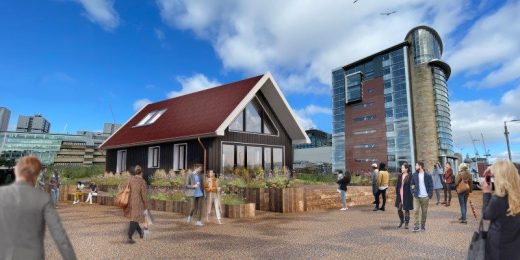
photo courtesy of architects office
Zero-carbon COP26 House Glasgow
COP26 Timber Conference
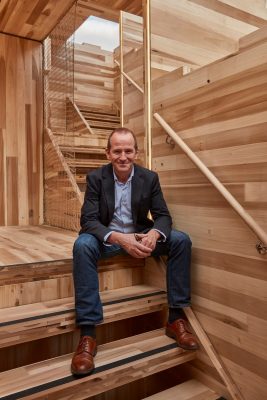
photo courtesy of architecture office
COP26 Wood for Good conference
Climate Change Events in Scotland
Climate Change Events in Scotland
COP26 is located in Glasgow.
Scottish Architecture
Cairngorms National Park Authority’s HQ, Grantown-on-Spey, Moray, Northern Scotland
Design: Moxon Architects
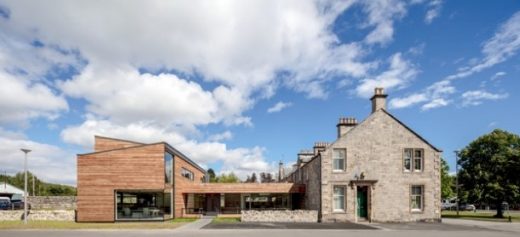
image courtesy of architects studio
Cairngorms National Park Authority HQ Building
Scottish Architect : Contemporary Studios – Scottish Architect Listings
Comments / photos for the Route to zero carbon article by FCBStudios page welcome

